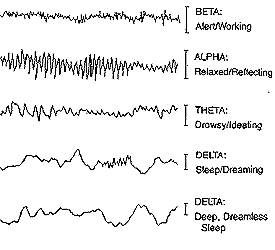The identification of brain waves is well established, but less so the notion of maintaining an optimal range regardless of one’s situation or activities. Modern life and its artificial schedules and routines have already created seasonal affective disorder, diseases of sedentary living and bad nutrition, and the tensions and stresses of technology and society. The modern idea that we are largely dominated by evolutionary instincts and impulses can overshadow expectations that our brain (and our emotions, feelings, outlooks, and behaviors) can reside in a healthy range.
 We know that brain waves reflect the brain status of any given moment. For adults, the delta and theta waves are produced during sleep. The awakened state is reflected in alpha waves: relaxed but alert. Beta waves dominate regular waking functions, from interested attention to focus to intensive to stressful.
We know that brain waves reflect the brain status of any given moment. For adults, the delta and theta waves are produced during sleep. The awakened state is reflected in alpha waves: relaxed but alert. Beta waves dominate regular waking functions, from interested attention to focus to intensive to stressful.
While beta waves reflect all of the functions of the awakened state, the brain is flexible and can adapt to circumstances, even welcoming optimal circumstances. But one must become conscious of optimal circumstances in order to foster brain health. While there are brain exercises for memory, the “exercises” that will bring us to optimal living are not so easily identified and implemented. They must be cultivated and pursued. This requires learning and reflection, a critical faculty, and an appreciation for natural settings wherein the brain can rest in alpha waves.
In the late 1970’s, biofeedback was the popular method for attempting to affect brain waves. The developer of biofeedback was Les Fehmi, who now calls his system “open-focus attention.” Similarly, the 1975 book Relaxation Response by cardiologist Herbert Benson became a break-through concept to address stress. Since then, Dr. Benson has studied Eastern methods of meditation for clinical input in the search to identify optimal brain flexibility. As Fehmi puts it, “Flexible attention is the sine qua non of health.”
Part of the Western response to technological society’s sources of stress, therefore, has been to find physiological coping mechanisms rather than to address the premises of modern technology and modern socioeconomic conditions, which have been exported to the rest of the world with the same ill results. In part, the conclusion that changes cannot be affected in such deeply-rooted material conditions leads to the search for palliatives. But these palliatives will not work without understanding the conditions, without recognizing that the cause is not addressed if mere palliatives are applied. This is the mistake of modern medicine (curing disease by obliterating symptoms) as much as modern diplomacy (curing what are judged inadequate, backward, or offensive political systems by obliterating them). The premises of modern technological society are not to be questioned.
Into the breach of Western values come various imports of original wisdom, usually broken or made ineffective by the transference from East to West. Most Westerners refuse to countenance Eastern thought because of their own extension of Western colonialist thinking, xenophobia, or inherited bias against what can be called exoticism.
In philosophy, Thoreau and Schopenhauer were notable 19th-century exceptions. In religion and spiritual thinking, Theosophy and Gurdjieff in the early 20th century tried their filtered and eccentric versions of East-West reconciliation. They were predecessors of New Age. Similarly, New Age has drawn on post-World War II physics and ethics to elaborate a cosmology and vision that varies from one source to another but is characterized by wholesale incorporation of Eastern ideas left without their material and cultural roots.
More scientifically-oriented examples include the collaborations of the Dalai Lama with Western scientists (such as Benson) to explore neurological foundations of Buddhist psychology, and the famous 1998 book, Zen and the Brain by neurologist and Zen practitioner James H. Austin, which remains an unrivaled source for bridging techniques of East and West.
The great challenge, then, is how to incorporate into the modern world solutions that will ameliorate the ills of modern society. Solutions will not appear within the modern political and technological realms because they are invested in the perpetuation of the ills. From where, then, will solutions come?
Richard Moss, author of the Mandala of Being, suggests that all human activity is ultimately subjective, both in self and experience of the world, and that our various subjectivities come together to form society. His solution emphasizes the experience of “Now,” which will sound familiar to New Age thinking popularized by, for example, Eckhart Tolle. Richard Moss, who was a physician, has since switched his approach to one of more social conviviality with his “radical aliveness” theme.
Unsuccessful approaches to East-West integration of ideas and techniques is not entirely cerebral. But too many suggest that by a trick of consciousness or sleight of mind or a Buddhism deprived of ethics or social awareness, we can transcend the ills of the world around us. Effectively, the ills of modern life are thereby ignored.
We live in a vacuum of indifference if the Now unsuccessfully becomes a code-word for “Me.” Solitude has little to do with “me” and my own problems or my cultural inheritance and has everything to do with nature and the natural world around us, which includes us. Our brains become fully aware of our world, our environment, by shaping our daily life to practices that naturally aligns us with the “biorhythms” of the universe.
